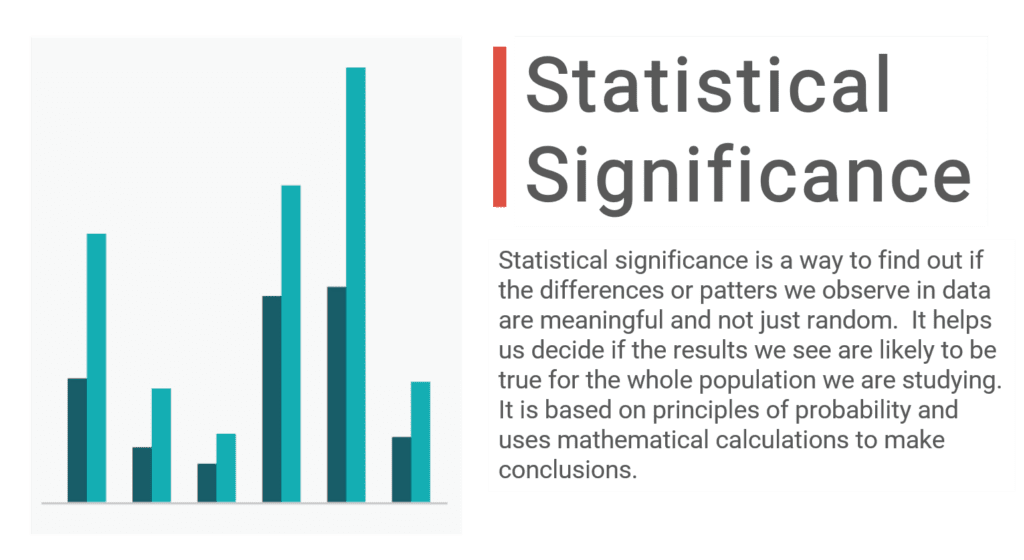In this article, we’re diving headfirst into the captivating world of statistical significance and practical significance. These two concepts hold the keys to unlocking the hidden messages within our data and helping us make wiser choices in our daily lives. It’s like having a superpower that enables us to separate the meaningful from the random coincidences.
Think about it—have you ever had to make a tough decision, like choosing between two extracurricular activities, selecting the best study strategies, or even deciding which movie to watch with your friends? Well, statistical significance and practical significance are your trusty companions guiding you toward the right path.
Understanding these concepts will help unravel the mysteries behind statistical results and empower you with the knowledge to become a savvy interpreter of data.
The Differences Between Statistical and Practical Significance

Statistical significance is the truth detector. It helps us determine if our findings happened by chance or if something is going on. When something is statistically significant, it means that what we discovered in our data probably didn’t occur randomly. We can have more confidence that our results are real and not just a fluke. But here’s the catch: statistical significance doesn’t tell us how big or important the effect is.
Enter . . . Practical Significance

Practical significance addresses real-world impact. Let’s say we test a new medicine that makes a cold slightly shorter, but only by a tiny bit. Sure, the change is statistically significant, but is it really going to make a noticeable difference to someone who’s sick? That’s where practical significance comes in.
The Power of Considering Both: Gain a More Complete Understanding of Our Results
To truly understand our results, we must consider the statistical and practical significance. It’s like putting together a puzzle with two important pieces. Sometimes, a finding can be statistically significant, showing it’s not just due to luck but might not have much impact in the real world. On the flip side, some findings might not show up as statistically significant, especially if we didn’t have a large group to study, but they could still be important and meaningful in our lives.
By considering both statistical and practical significance, we become smarter decision-makers. Practical significance helps us determine if a finding is important enough to influence our choices. It guides us to focus our resources wisely. We don’t just look at the numbers; we consider what they mean in the real world. It’s like using a magnifying glass to zoom in on the details and stepping back to see the whole scene. By embracing both perspectives, we become skilled interpreters of data, unlocking its true power. Imagine if we implemented a change that is statistically significant but not practically significant. We might waste time, effort, and resources on something that doesn’t make a difference. We want to make sure our actions have a real impact.
How Do We Understand and Compare the Statistical and Practical Significance of Data Experiment Results or Hypothesis Tests?
Unlocking the p-value mystery
First things first, let’s talk about the mysterious p-value. It’s like a secret code that tells us if our results happened by chance or if there’s something more going on. If the p-value is smaller than our chosen level, often 0.05, it means our results are probably not due to luck. We can confidently say they are statistically significant. In simpler terms, our findings are not just a random event.
Measuring the magnitude
Statistical significance can sometimes play tricks on us, especially when we have a large group to study. Even tiny, practically unnoticeable differences can be statistically significant. To tackle this, we calculate the effect size. It’s a number that shows us how big the difference or relationship we found really is. Different data types and tests use measures like Cohen’s d, Eta squared, and R squared to help us better understand the effect size.
The confidence interval: Our guessing range
Imagine having a magical range of guesses. That’s what a confidence interval is! Based on our data, it tells us where we believe the true answer lies. A smaller confidence interval means we have a more precise guess, while a larger one means we’re less certain. If our confidence interval includes zero (for differences) or one (for ratios), then we can’t be sure our finding is statistically significant. But if zero or one is outside the interval, that’s a sign our result is statistically significant.
Bringing it to the real world
We’ve examined the statistical significance, effect size, and confidence interval, but now we must ask ourselves, “Does it really matter?” This is where practical significance comes into play. Let’s say a new medicine helps people recover just 1% faster. It may be statistically significant, but is it truly important? We need to think about the costs and benefits, too. If the medicine is much more expensive or has more side effects, it might not be worth it, even if it’s statistically significant. Practical significance considers the real-life impact of our findings.
Essential Tips Regarding Statistical Significance
As you explore the significance of results in data experiments, beware of the pitfalls that lie ahead.
Tip 1: Look beyond significance testing
One common mistake is fixating solely on whether something is statistically significant, forgetting the importance of effect size and confidence intervals. Assessing practical significance is not just about asking, “How large is the effect we discovered?” but also about comparing this effect size to established benchmarks or guidelines. This comparison is key to determining if the size of the effect is substantial enough to truly matter in practical terms. It allows us to evaluate whether the statistically significant results also have significant real-world implications.
Tip 2: Avoid cherry-picking
Imagine this scenario: Only showcasing results supporting your preconceived notions while ignoring those that are not. This selective sharing, known as cherry-picking, can lead to misleading conclusions. To accurately portray your findings, it is crucial to share all the tests you conducted, not just the ones that align with your expectations. Honesty and transparency pave the way for reliable interpretations.
Tip 3: Embrace the uncertainty
In the captivating world of statistics, uncertainty looms in the shadows. Every number we encounter holds a level of uncertainty. Acknowledging this fact prevents unwarranted certainty in our findings. Remember, there is always some level of uncertainty present in statistical results. Embracing this uncertainty cultivates a curious mindset and encourages further exploration.
Statistical Exploration of Sports Performance
 Sasha has an insatiable passion for basketball. Determined to improve her shooting skills, Sasha explored the relationship between practice time and basketball shooting accuracy. As Sasha meticulously crunched the numbers, an intriguing discovery emerged—a statistically significant connection between practice time and shooting accuracy.
Sasha has an insatiable passion for basketball. Determined to improve her shooting skills, Sasha explored the relationship between practice time and basketball shooting accuracy. As Sasha meticulously crunched the numbers, an intriguing discovery emerged—a statistically significant connection between practice time and shooting accuracy.
The significance of this finding was undeniable, but Sasha understood that there was more to the story than statistical significance alone. Plus, she wanted to make sure her sacrifice of choosing to practice over engaging in other activities was worth it.
Digging deeper, Sasha pondered the effect size—the magnitude of practice time’s impact on shooting accuracy. She questioned, “Does more practice lead to a substantial improvement in shooting accuracy, or is the effect merely minimal?”
Sasha recognized the importance of evaluating the practical significance—the real-world implications of her findings. She considered a scenario where a slight increase in shooting accuracy resulted from extra practice. While statistically significant, Sasha realized that this minor improvement might not significantly impact her overall game performance. Practical significance prompted Sasha to examine the broader context and weigh the true value of the findings in the real world of basketball.
When discussing the findings with her coach, she sought to present a complete picture. She understood the importance of sharing all the test outcomes, not simply ones she had expected or found beneficial. This commitment to fairness allowed Sasha to provide a comprehensive interpretation reflecting her statistical analysis’s integrity.
Throughout her statistical journey, Sasha encountered an ever-present companion—uncertainty. Sasha grasped the notion that statistical analysis carries a level of uncertainty inherent to the nature of data. As such, she approached her findings with humility, acknowledging that absolute certainty might be elusive. This acknowledgment of uncertainty taught Sasha to avoid biases and approach findings with an open mind.